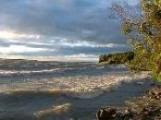Simcoe Pollution's source sought
Pollution's source sought
The City of Orillia has been conducting studies to determine where pollutants leaching into Lake Simcoe are coming from.
A report from the Ministry of Environment (MoE) released last January tells the city to address the "significant leachate" that's making its way into Lake Simcoe from the Kitchener Street landfill.
The ministry inspected the site twice in August 2009 and found high levels of phosphorous in the lake "at several sampling points."
The city has since launched studies to determine where exactly the phosphorous is coming from, said public works director Peter Dance.
"There is no sense trying to solve a problem unless you really understand the source and the pathways," Dance said on Monday. "You make sure you're solving the right problem."
Emily Moore, senior environmental officer with the MoE's Barrie district office, says the MoE has given the city the go-ahead for a one-year monitoring program to determine off-site impacts.
"As part of this monitoring work, the city will be doing a phosphorous assessment to identify potential phosphorous sources to the lake and any impacts," Moore wrote in an email response.
Following the Lake Simcoe Protection Act, the ministry has made the lake's protection a priority, she wrote. Included in the plan is a phosphorous reduction strategy.
"The phosphorous reduction strategy targets are based on a 35-year plan that will help to restore normal levels of phosphorous in the lake."
Despite the MoE's initial report, there's no proof the leachate is coming from the existing Kitchener Street landfill, Dance said.
The problem could be coming from a number of sources.
Advertisement
Other possible culprits are the waste water plant, which is currently operating within its phosphorous targets, or the former dump, which was decommissioned in 1967 and lies beneath the lakeside Kitchener Park's soccer pitches.
It could also be coming from surface run-off, storm water outlets, or a nearby residential area, Dance said.
"You've got a pretty complex system there depending on which way the currents are going. There is a lot of potential."
The city expects to report its findings to the MoE in February, Dance said.



